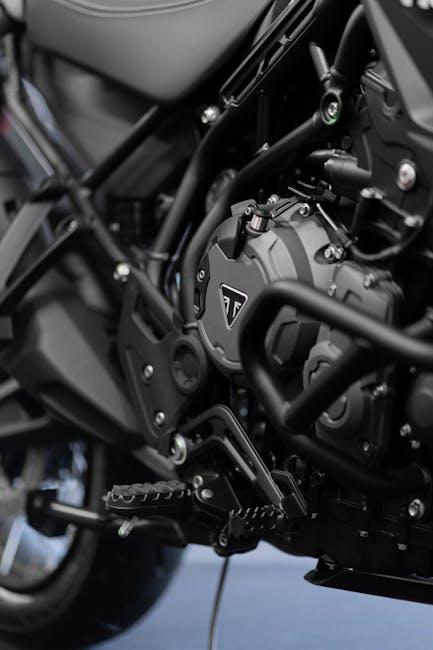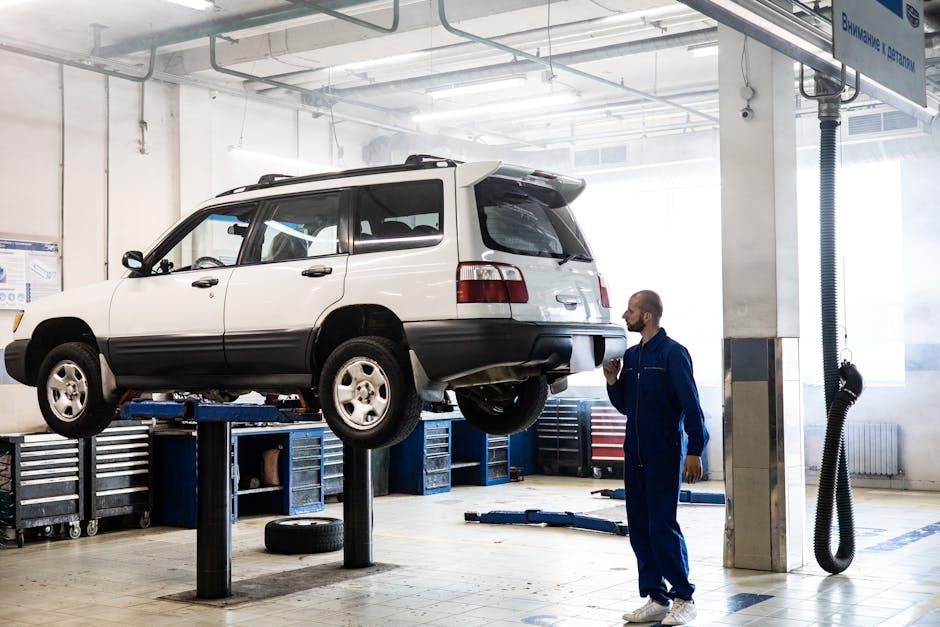When we talk about a car’s suspension, it’s more than just springs and shocks hidden beneath the chassis—it’s the silent architect of your vehicle’s comfort, control, and safety. A well-tuned suspension system smooths out the rough patches of the road, keeps the tires gripping firmly to the pavement, and ensures that every twist and turn feels precise rather than precarious. But how do you know if this vital system is pulling its weight or quietly compromising your drive? Testing car suspension performance isn’t just for mechanics with high-tech tools; it’s a critical skill for any driver who values both comfort and safety. In this article, we’ll explore practical methods and insightful techniques to evaluate how well your car’s suspension handles the road, helping you maintain your vehicle’s balance and boost your confidence behind the wheel.
Table of Contents
- Understanding Suspension Components and Their Roles
- Evaluating Ride Comfort Through Practical Driving Scenarios
- Assessing Handling and Stability on Varied Road Surfaces
- Identifying Signs of Suspension Wear and Tear
- Utilizing Professional Diagnostic Tools for Accurate Measurement
- Implementing Maintenance Tips to Enhance Suspension Longevity
- Q&A
- Key Takeaways

Understanding Suspension Components and Their Roles
Every component within a car’s suspension system plays a pivotal role in ensuring smooth rides and optimal handling. At the heart of this intricate setup are the springs, which absorb shocks from uneven road surfaces, preventing harsh impacts from jolting the cabin. Meanwhile, the shock absorbers control the springs’ oscillations, stabilizing the vehicle and minimizing bounce. Complementing these, the control arms and ball joints maintain wheel alignment and allow vertical movement while steering responsiveness is managed by the struts. Each piece, from bushings to sway bars, contributes to balancing comfort, safety, and driving precision, making a thorough understanding essential for effective testing.
- Springs: Cushion shocks and support vehicle weight.
- Shock Absorbers: Dampen spring vibrations for stability.
- Control Arms: Connect wheels to the frame and allow controlled movement.
- Struts: Act as structural support and assist with steering.
- Sway Bars: Reduce body roll during turns.
| Component | Primary Function | Common Symptoms of Wear |
|---|---|---|
| Springs | Absorb road bumps | Rear sagging, uneven ride height |
| Shock Absorbers | Dampen vibrations | Bouncy ride, poor handling |
| Control Arms | Maintain wheel position | Clunking noises, misalignment |
| Sway Bars | Reduce rolling motion | Excessive body lean on turns |

Evaluating Ride Comfort Through Practical Driving Scenarios
To truly understand how a suspension system impacts ride quality, put it through its paces on diverse surfaces. Smooth highways reveal how well the suspension maintains vehicle stability and minimizes road noise, while rough city streets and uneven country lanes expose its ability to absorb shocks from potholes, gravel, and unexpected bumps. Pay close attention to how the car feels in each situation — are jolts softened or transmitted sharply to the cabin? Is body roll noticeable during cornering, or does the vehicle remain composed?
When conducting these tests, consider targeting specific driving conditions that challenge suspension characteristics:
- Speed bumps and sharp dips: Check for smooth transitions without harsh rebounds.
- Uneven pavement: Observe how the suspension negotiates continuous vibrations and irregularities.
- High-speed corners: Assess lateral grip and control, crucial for both comfort and safety.
- Heavy braking and acceleration: Feel for nose dive or squat, indicating damping effectiveness.
| Test Scenario | Key Observations | Comfort Indicator |
|---|---|---|
| Speed Bumps | Minimal cabin jolt, steady rebound | Excellent |
| Uneven Pavement | Consistent vibration absorbed | Good |
| High-Speed Corners | Stable body, reduced roll | Very Good |
| Braking & Acceleration | Controlled dive and squat | Good |

Assessing Handling and Stability on Varied Road Surfaces
When evaluating a car’s suspension, it’s crucial to observe how the vehicle responds across different textures and road conditions. Testing on smooth highways, rough gravel, wet asphalt, and uneven dirt tracks reveals the suspension’s ability to maintain tire contact and absorb shocks. Pay close attention to the steering feedback and body roll during cornering—these factors unveil the balance between comfort and control. A suspension that adapts seamlessly will minimize unwanted vibrations and erratic movements, making every ride safer and more enjoyable.
In addition to real-world driving, structured tests can help quantify stability variations. Here’s a quick comparison of how suspension components typically perform across surfaces:
| Road Surface | Shock Absorption | Grip & Handling | Common Issues |
|---|---|---|---|
| Smooth Asphalt | High | Optimal | Minor body roll |
| Gravel | Moderate | Variable | Loosened grip, vibrations |
| Wet Asphalt | High | Reduced | Hydroplaning risk |
| Dirt Roads | Low to Moderate | Challenged | Instability, slipping |
- Focus on tire behavior: Tires must stay connected to the ground, regardless of bumps or curves.
- Notice suspension travel: Excessive or minimal movement can indicate over- or under-performance.
- Evaluate driver comfort: Jarring impacts or excessive sway degrade the experience and safety.

Identifying Signs of Suspension Wear and Tear
When your car’s suspension begins to show signs of wear, subtle cues often precede major failures. Pay close attention to changes in ride comfort or unusual noises. A common indicator is a bouncy or unstable ride, especially when driving over uneven pavement, which suggests worn shock absorbers or struts. Another warning sign is visible damage such as leaks of hydraulic fluid on the shocks, or cracked, sagging, or rusted springs. Such physical evidence can quickly escalate into compromised handling and increased tire wear if not addressed.
To systematically assess the condition, look for these key symptoms:
- Uneven tire tread wear, which hints at misalignment or weakened suspension components.
- Clunking or knocking sounds when hitting bumps, signaling loose or deteriorated bushings and mounts.
- Excessive body roll or nose-diving during turns or abrupt stops, indicating weakening stabilizer bars or worn shocks.
- Vehicle sagging to one side, often due to damaged or compressed springs.
| Symptom | Possible Cause | Impact on Performance |
|---|---|---|
| Bouncy ride | Worn shock absorbers | Reduced stability |
| Uneven tire wear | Misalignment or worn bushings | Handling issues |
| Squeaking noises | Dry or damaged bushings | Increased wear on components |
| Vehicle leaning | Broken or sagging springs | Imbalanced handling |

Utilizing Professional Diagnostic Tools for Accurate Measurement
Achieving pinpoint accuracy in suspension testing heavily relies on the use of expert-grade diagnostic instruments. These tools allow technicians to glean precise data that visual inspections alone cannot reveal. Devices like electronic shock absorbers testers, bounce testers, and computerized suspension analyzers provide real-time feedback on how each component behaves under stress, offering a detailed picture of wear and degradation. Incorporating such technology transforms subjective assessments into measurable results, facilitating effective maintenance decisions.
When conducting suspension diagnostics, consider integrating the following professional tools into your workflow:
- Digital shock absorber tester – measures damping force and rebound rate.
- Laser ride height sensors – detect uneven suspension height and alignment issues.
- Chassis dynamometer – simulates road conditions while collecting suspension response data.
- High-speed cameras – capture the suspension’s dynamic movement frame-by-frame.
| Tool | Key Measurement | Benefit |
|---|---|---|
| Shock Absorber Tester | Damping force (N) | Quantifies shock performance precisely |
| Laser Ride Height Sensor | Height variation (mm) | Detects alignment & load imbalance |
| Chassis Dynamometer | Dynamic response | Simulates real driving conditions |

Implementing Maintenance Tips to Enhance Suspension Longevity
Regular care is the secret to extending the life of your suspension system. Maintaining proper tire pressure ensures that each component absorbs shocks evenly, reducing wear and tear. Additionally, don’t overlook the importance of routine inspections — checking for leaks, cracks, and worn bushings can prevent minor issues from snowballing into costly repairs. Incorporating these simple practices into your vehicle care routine helps keep your suspension responsive and reliable over the long haul.
Implementing strategic maintenance isn’t just about inspections; it also involves smart driving habits that lessen the strain on suspension parts. Avoiding potholes and rough terrain whenever possible, and reducing harsh braking or sudden acceleration can significantly diminish stress on shocks and struts. Below is a quick reference guide to effective suspension maintenance habits:
- Check tire alignment every 12,000 miles
- Inspect shock absorbers twice a year
- Replace worn bushings as soon as damage is noticed
- Keep tires properly inflated according to manufacturer specs
| Maintenance Task | Recommended Interval |
|---|---|
| Shock Absorber Inspection | Every 6 months |
| Tire Pressure Check | Monthly |
| Wheel Alignment | Every 12,000 miles |
| Bushing Examination | With every suspension inspection |
Q&A
Q&A: How to Test Car Suspension Performance
Q1: Why is testing car suspension performance important?
A1: Suspension is the unsung hero of your vehicle’s ride quality and safety. Testing its performance ensures your car handles well, absorbs shocks effectively, and maintains tire contact with the road — all vital for control and comfort.
Q2: What are the basic signs that indicate suspension might be underperforming?
A2: Look out for excessive bouncing after bumps, uneven tire wear, drifting during turns, nose-diving when braking, or unusual noises like clunks or squeaks. These clues hint at worn components or imbalance.
Q3: How can I perform a simple bounce test at home?
A3: With the car parked, push down hard on one corner and release. A properly functioning suspension should bounce back smoothly and settle quickly within one or two oscillations. Multiple bounces suggest worn shocks or struts.
Q4: Is it enough to visually inspect suspension parts to gauge performance?
A4: Visuals help spot obvious damage—leaks, rust, broken springs—but they don’t reveal hidden problems like diminished damping. Hands-on tests or professional diagnostics provide a more accurate picture.
Q5: What role does a road test play in suspension testing?
A5: Driving over various surfaces — potholes, speed bumps, sharp turns — is the ultimate real-world evaluation. It reveals how the suspension responds dynamically, highlighting any instability, excess noise, or harshness.
Q6: Can professional tools enhance suspension testing?
A6: Absolutely. Devices like shock absorbers testers, alignment machines, and oscilloscopes offer precise measurements of damping force, geometry, and ride characteristics that are impossible to gauge manually.
Q7: How often should suspension be tested?
A7: Regular inspections every 12,000 to 15,000 miles or during routine maintenance are advisable. But if you experience unusual handling or discomfort, test sooner to prevent safety risks.
Q8: Are different types of suspensions tested differently?
A8: Yes. For example, independent suspensions may require checking each wheel separately, while solid axle setups often need cross-axle evaluations. Knowing your vehicle’s suspension type helps tailor the tests.
Q9: What simple DIY tips can improve suspension health between tests?
A9: Keep tires properly inflated, avoid overloading your car, drive cautiously over rough terrain, and replace worn bushings or dampers promptly. Proactive care extends suspension lifespan and performance.
Q10: When should I see a professional about suspension issues?
A10: If your tests reveal persistent bouncing, uneven tire wear, steering vagueness, or noises you can’t fix yourself, it’s time to consult a mechanic. Suspension health directly affects your safety and driving pleasure.
Key Takeaways
In the end, testing your car’s suspension performance is more than just a technical checklist—it’s about tuning the very heart of your driving experience. Whether you’re a casual weekend driver or a dedicated enthusiast, understanding how your suspension responds can transform every journey into a smoother, safer, and more controlled adventure. By combining careful observation, practical testing, and a bit of patience, you’ll not only ensure your vehicle’s optimal performance but also deepen your connection to the road beneath you. So, take the time to test and perfect—you and your suspension will thank you for it.

